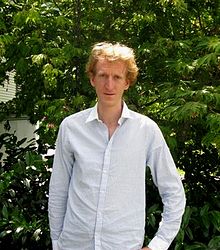Ben Green (mathematician)
This poorly sourced must be removed immediately from the article and its talk page, especially if potentially libelous. )Find sources: "Ben Green" mathematician – news · newspapers · books · scholar · JSTOR (January 2022) |
Ben Green | |
|---|---|
 Green in 2010 | |
| Born | Ben Joseph Green 27 February 1977 Bristol, England |
| Alma mater | Trinity College, Cambridge (BA, MMath, PhD) |
| Awards | Clay Research Award (2004) Salem Prize (2005) Whitehead Prize (2005) SASTRA Ramanujan Prize (2007) EMS Prize (2008) Fellow of the Royal Society (2010) Sylvester Medal (2014) Senior Whitehead Prize (2019) |
| Scientific career | |
| Fields | Mathematics |
| Institutions | University of Bristol University of Cambridge University of Oxford Princeton University University of British Columbia Massachusetts Institute of Technology |
| Thesis | Topics in Arithmetic Combinatorics (2003) |
| Doctoral advisor | Timothy Gowers |
| Doctoral students | Vicky Neale Adam Harper |
Ben Joseph Green
Early life and education
Ben Green was born on 27 February 1977 in
Mathematics
The majority of Green's research is in the fields of
Amongst Green's early results in additive combinatorics are an improvement of a result of Jean Bourgain of the size of arithmetic progressions in sumsets,[3] as well as a proof of the Cameron–Erdős conjecture on sum-free sets of natural numbers.[4] He also proved an arithmetic regularity lemma[5] for functions defined on the first natural numbers, somewhat analogous to the Szemerédi regularity lemma for graphs.
From 2004–2010, in joint work with
Green has also collaborated with Emmanuel Breuillard on topics in group theory. In particular, jointly with Terence Tao, they proved a structure theorem[8] for approximate groups, generalising the Freiman-Ruzsa theorem on sets of integers with small doubling. Green also has worked, jointly with Kevin Ford and Sean Eberhard, on the theory of the symmetric group, in particular on what proportion of its elements fix a set of size .[9]
Green and Tao also have a paper[10] on algebraic combinatorial geometry, resolving the Dirac-Motzkin conjecture (see Sylvester–Gallai theorem). In particular they prove that, given any collection of points in the plane that are not all
Kevin Ford, Ben Green, Sergei Konyagin, James Maynard and Terence Tao, initially in two separate research groups and then in combination, improved the lower bound for the size of the longest gap between two consecutive primes of size at most .[11] The form of the previously best-known bound, essentially due to Rankin, had not been improved for 76 years.
More recently Green has considered questions in arithmetic Ramsey theory. Together with Tom Sanders he proved that, if a sufficiently large finite field of prime order is coloured with a fixed number of colours, then the field has elements such that all have the same colour.[12]
Green has also been involved with the new developments of Croot-Lev-Pach-Ellenberg-Gijswijt on applying the
Awards and honours
Green has been a Fellow of the Royal Society since 2010,[14] and a Fellow of the American Mathematical Society since 2012.[15] Green was chosen by the German Mathematical Society to deliver a Gauss Lectureship in 2013. He has received several awards:
- 2004: Clay Research Award
- 2005: Salem Prize
- 2005: Whitehead Prize[16]
- 2007: SASTRA Ramanujan Prize
- 2008: European Mathematical Society prize recipient
- 2014: Sylvester Medal, awarded by the Royal Society.
- 2019: Senior Whitehead Prize of the London Mathematical Society
References
- ^ Ben Green's results at International Mathematical Olympiad
- S2CID 1883951.
- S2CID 120755105.
- S2CID 119615076.
- S2CID 17451915.
- JSTOR 20752252.
- JSTOR 23350588.
- S2CID 119603959.
- S2CID 15188628.
- S2CID 15813230.
- ].
- S2CID 119140038.
- S2CID 119150134.
- ^ "- Royal Society".
- ^ List of Fellows of the American Mathematical Society. Retrieved 19 January 2013.
- ^ "List of LMS prize winners – London Mathematical Society".
External links
- Ben Green personal homepage at Oxford
- Ben Green faculty page at Oxford Archived 26 April 2014 at the Wayback Machine
- Ben Green Homepage at Trinity College, Cambridge
- Clay Research Award 2004 announcement
- Ben Green at the Mathematics Genealogy Project
- math.NT/0404188 – Preprint on arbitrarily long arithmetic progressions on primes







